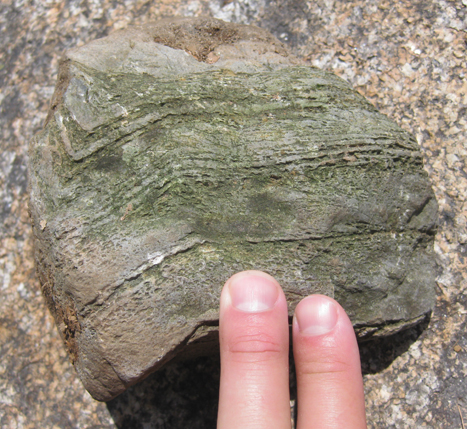“Pocket folds,” as my Rockies co-instructor Pete Berquist has defined them, are rock samples exhibiting folds that are small enough to stick in your pocket (and take back to your lab). Here’s a pocket fold that I found last week in the White Mountains of New Hampshire:
I brought it home, and today I unpacked it from the car, along with about 70 pounds of other samples. I turned on the hot water tap and took out a critical piece of sample prep equipment, the wire brush (suitable for cleaning a grill), and scrubbed off all the algae. You should only use wire brushes on relatively hard samples. Because the steel wires have a hardness of 5.5, they will scratch rocks like limestone, which is made of 3.0-hardness calcite. I also gave it a quick bath in 4.5 molar HCl, to kill off any remaining algae. A rinse, and then I set it in the sun to dry.
My White Mountain pocket fold is a quartzite, with some nice graded beds, which probably show up better when they are filled in with algae. Regardless, here’s the cleaned up sample, a gray ghost of a pocket fold:
If you collect field samples for teaching purposes or just because you find them beautiful, what steps do you take to prepare them?



Scouring powder and brush (Ajax or the like) for hard rocks, Soft Scrub (CaCO3 abrasive) & toothbrush for softer rocks and mins and for softest and friable rocks maybe just a rinse or spray with a bit of brushing to get the worst dirt and loose material off. Something I found works nice for bring out sedimentary textures and (pocket) structures generally is to cut the sample in a rock saw, then coat half of that face with lacquer or clear nail polish. I used to get a lot of funny looks when I would buy several little bottles on sale, but many more if I tries to explain they were for my rock samples. Also, as a general rule, try to get samples with faces of varying degree of weathering, and use your hammer to whack a fresh surface- different textures and structures can be highlighted on different faces. From a teaching/learning perspective, somewhat weathered faces are what you’re most likely to encounter in the real world. I can recognize a number of the bedrock types around here based on the soil color that develops on them… a very useful skill given our thick soils.
Also, for iron staining, boiling insoluble and acid resistant samples in oxalic acid (USE PYREX) can get a surprising amount of the red and orange off, though normally not all of it.
Scouring powder and brush (Ajax or the like) for hard rocks, Soft Scrub (CaCO3 abrasive) & toothbrush for softer rocks and mins and for softest and friable rocks maybe just a rinse or spray with a bit of brushing to get the worst dirt and loose material off. Something I found works nice for bring out sedimentary textures and (pocket) structures generally is to cut the sample in a rock saw, then coat half of that face with lacquer or clear nail polish. I used to get a lot of funny looks when I would buy several little bottles on sale, but many more if I tries to explain they were for my rock samples. Also, as a general rule, try to get samples with faces of varying degree of weathering, and use your hammer to whack a fresh surface- different textures and structures can be highlighted on different faces. From a teaching/learning perspective, somewhat weathered faces are what you’re most likely to encounter in the real world. I can recognize a number of the bedrock types around here based on the soil color that develops on them… a very useful skill given our thick soils.
Also, for iron staining, boiling insoluble and acid resistant samples in oxalic acid (USE PYREX) can get a surprising amount of the red and orange off, though normally not all of it.
in Ontario they blast the moss off an entire outcrop with fire hoses, scrub it with bleach, and come back the next season to map it.
in Ontario they blast the moss off an entire outcrop with fire hoses, scrub it with bleach, and come back the next season to map it.